|
Published monthly for CC employees by Clinical
Center Communications
November 1999
Sickle cell
anemia study
Awards honor
CC staff
Quality of
worklife
HHS Secretary
Shalala visits
New patient
rep appointed
Artwork donated
Gallin receives
flu shot
News briefs
|
|
Study points to role for nitric oxide in sickle cell anemia
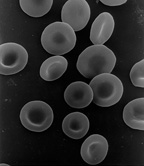 |
|
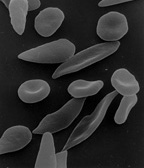 |
|
At left, healthy, normal red blood cells. At right, the misshapen
red blood cells characteristic of sickle cell anemia. The hereditary
disease affects about 1 in every 500 African-Americans, causing
pain described by some as "a sledgehammer slamming bone."
(Photos courtesy of Drs. Noguchi, Rodgers, and Schechter of
NIDDK.)
|
|
A study headed by Dr. Mark T. Gladwin, of the Clinical Center's
Critical Care Medicine Department (CCMD), found that increasing
levels of nitric oxide in the blood may offer new options for
treating sickle cell anemia, the most common inherited blood
disorder in the country.
In the study, described in last month's "Journal of Clinical
Investigation," Dr. Gladwin and colleagues in CCMD, NIDDK,
and NHLBI examined how nitric oxide acts on hemoglobin, the oxygen-carrying
molecule in red blood cells.
Nitric oxide, a gas produced in many parts of the body, relaxes
the smooth muscle cells in blood vessels. As the muscles relax,
the vessels expand and allow more blood to pass through. Improving
blood flow is a critical aspect in treating the painful and potentially
deadly complications associated with sickle cell anemia.
The study demonstrates that when nitric oxide is inhaled,
it binds to hemoglobin. Once attached, the gas hitches a ride
through the bloodstream, and may dilate vessels as it passes
through.
"This study is the first clinical demonstration of how
nitric oxide binds to hemoglobin and that hemoglobin carries
the gas as blood moves through the body," noted Dr. Frederick
Ognibene of CCMD.
In sickle cell anemia, hemoglobin molecules cluster into rigid
spikes as oxygen is lost. The result is misshapen blood cells
that slow blood flow and can block vessels entirely. When blood
flow is disrupted, oxygen can't be delivered to the body. That
causes painful and potentially deadly damage to organs and tissues.
"Without oxygen, tissues die, and dying tissue hurts,"
Dr. Gladwin explained. "Some patients describe the pain
as like a sledgehammer slamming bone."
The research team hopes that these early studies will lead
to new treatments for the life-threatening complications of this
yet-incurable disease.
The next step is to use magnetic resonance imaging to map
changes in blood flow to certain muscle groups following nitric
oxide inhalation therapy, researchers say.
"Sickle cell anemia is a painful and debilitating disease
that affects thousands of Americans," said Dr. John I. Gallin,
CC director. "The Clinical Center's investigations in this
area reflect our commitment to developing new and better therapies
through innovative clinical research."
Sickle cell anemia is most prevalent in African-Americans.
About 1 in every 500 African-Americans has the disease; 1 in
12 carries the sickle cell trait.
-by Sara Byars
index
|
Awards honor CC staff
At the NIH Clinical Center Director's Annual Address and Awards
Ceremony, held on Oct. 4, numerous CC employees were honored
for their service and dedication to the mission of the hospital.
"Collaboration is a key concept at the Clinical Center,"
said CC Director Dr. John Gallin. "It drives not only the
science conducted here, but also every aspect of management and
operations. Our dedicated staff members conduct the critical
collaborations that bring success. It is the contributions of
these individuals we honor today and we look to them for future
growth."
A reception in the Visitor Information Center followed the
ceremony.
In the category of administration, awards went to the following:
- Elaine Ayres, Office of Administrative Management and Planning,
for significant contribution to the Clinical Center's goal of
operational effectiveness and efficiency.
- Alberta Bourn, Nutrition Department, for outstanding long-term
leadership of the Clinical Center Nutrition Department.
- Laura Cearnal, Office of the Director, for providing exemplary
staff support to Clinical Center Grand Rounds and RoundTable
presentations; for coordinating Clinical Center efforts to create
a Pain and Palliative Care Service; and for providing exemplary
support to the establishment and maintenance of the Clinical
Center's Board of Scientific Counselors.
- Charles E. Daniels, Pharmacy Department, for sustained leadership
of the Pharmacy Department.
- Bradley Henry, Sodexho-Marriott, for performance of duties
above and beyond the call of duty in the maintenance of the South
Entry lobby.
- David R. Kohler, Pharmacy Department, for the creative use
of technology to disseminate information on handling of hazardous
drugs in the protection of the safety of NIH staff.
- Francis A. LaBosco, Materials Management Department, for
achievements exemplified by his notable and exceptional initiative
and resourcefulness in reinventing the Materials Management Department.
- Barbara Merchant, NIDDK, for leadership and innovative administrative
efforts to support the newly initiated organ transplant program.
- Gracie A. Millender, Outpatient Department, for achievements
in administrative support which exemplify the mission of the
Clinical Center and the NIH.
- Stephen Rosenfeld, Information Systems Department, for leadership
during a time of transition in the Information Systems Department.
- Maureen L. Sampson, Clinical Pathology Department, for achievement
in teaching as exemplified by contributions to train others in
the computer-assisted generation of slides and posters, and for
the design and implementation of the Clinical Pathology website.
- Jane M. Thurber, Office of Human Resources Management, for
great skill and diligence in developing management reports regarding
human resources status and trends.
- Ellen Williams, Equal Employment Opportunity Office, for
leadership and extraordinary service to support diversity and
equal employment opportunity in the Clinical Center.
- ITAS Implementation Group - Nicole M. Butler, Office of Administrative
Management and Planning; Warren J. Moyer, Office of Financial
Resources Management; James T. Pitts, Information Systems Department;
Lynda N. Ray, Office of Administrative Management and Planning,
for administrative excellence as demonstrated by the implementation
of the Integrated Time and Attendance System in the Clinical
Center.
- Nurse Recruitment Improvement Group - Marsha Brown, Ana Ferreira,
Linda Linko, Sherry Meyers, Clarissa Mickle, Teresa Peduzzi,
Jeanne Radcliffe, Carol Romano, Rosalie Smith, Susan Squires,
Diane Walsh, Therese White, Lomar Yap, all of the Nursing Department;
and Barbara Lang, Office of Human Resources Management, for diligent
and untiring efforts to study and improve the process of hiring
nurses in the Clinical Center.
- South Lobby Entry Group - Sara R. Byars, Office of Clinical
Center Communications; Ann M. Ellis, Office of Facility Management;
Adrienne R. Farrar, Social Work Department; Steven C. Groban,
Outpatient Department; Henry D. Primas, Housekeeping and Fabric
Care Department; Andrea Rander, Volunteer Office; Donald A. Sebastian,
Division of Engineering Services; Terri Wakefield, Nursing Department;
Janice H. Weymouth, Office of the Director; James H. Wilson,
Office of Facility Management, for efforts resulting in the successful
opening and operation of the Clinical Center's South Lobby.
Jesse Ferguson Customer Service Awards went to the following:
- Mary Hall, Medical Record Department, in recognition of the
outstanding customer service provided as a protocol specialist
in the Protocol Coordination Service Center.
- Barbara B. Isom, Department of Transfusion Medicine, for
constant, capable, and caring service to Clinical Center patients
who require transfusions during the late night and early morning.
- Karen Kaczorowski, Outpatient Department, for achievement
in customer service which exemplifies the mission of the Clinical
Center and the NIH.
- Edna M. Lowe, Housekeeping and Fabric Care Department, for
outstanding and dedicated customer service to the patients, visitors,
and staff of the Clinical Center.
- Al Rexroad, Office of Clinical Center Communications, for
long-standing contributions to the Clinical Center through leadership
of the Special Events Section.
- Daniel Rinehuls, Office of Financial Resources Management,
in recognition of outstanding performance, customer service,
and timeliness in completion of the initial phases of the Activity-Based-Costing
initiative.
- Cafeteria Hospitality Group - Elizabeth Appiah, Lynn Champ,
Van Phan, of Guest Services, Inc., for excellent customer relations
and efficient service in the ACRF cafeteria.
- Facilities Management Group - Scott Robinson, Dyal Sharma,
Division of Engineering Services, for sustained cooperation in
developing an excellent facilities management program in the
Clinical Center.
- Nutrition Coordination Group - Elva Barrett, Sherry Parker,
Grace Raye, Pattie Russell, Sandy Seubert, Kristin Stafford,
Kimberly Williams, Maxine Wilson, all of the Nutrition Department,
for surpassing program goals for the sustained delivery of superior
customer service in the coordination of meal activities at the
patient care unit level.
In the category of patient care, awards went to the following:
- Barbara Bierer, NHLBI, for continued service and contributions
in support of the Clinical Center programs.
- Helena L. Royster, Pharmacy Department, for sustained contributions
to excellence in pharmacy patient care, through provision of
drug information and product-related services as the night pharmacist.
- Jerry Sachs, for significant contributions as a member of
the Clinical Center Patient Advisory Group.
- Anthony Suffredini, Critical Care Medicine Department, for
being an outstanding clinician whose excellence and dedication
to patient care exemplifies the qualities necessary for the Clinical
Center to achieve its objectives to provide first-rate patient
care.
- Benjamin Williams, Housekeeping and Fabric Care Department,
for continued outstanding service to patients, staff, and visitors
of the Clinical Center.
- Bereavement Assistance Group - Nancy Ames, Nursing Department;
Margaret Bevans, Nursing Department; Richard Childs, NHLBI; Eileen
Dominick, Social Work Department; Peter Eichacker, Critical Care
Medicine Department; Liz Hale, Nursing Department; Karen Morrow,
Spiritual Ministry Department; Rachelle Ramirez, Nursing Department,
Renee Stubbs, Rehabilitation Medicine Department, for the innovative
initiative shown as a team in developing a program to assist
patients' families in the bereavement process.
- DTM Laboratory Information Systems Group - Janet Browning,
Sherry L. Sheldon, Department of Transfusion Medicine, for extraordinary
effort in developing and implementing the Laboratory Information
Systems for the Department of Transfusion Medicine.
In the category of science, an award went to the following:
- Joseph Kovacs, Critical Care Medicine Department, for developing
important research initiatives in the areas of immunotherapy
for HIV disease and management of pneumocystis pneumonia.
In the category of strategic initiatives, awards went to
the following:
- MRD Operational Review Group - Patricia S. Coffey, Kai E.
Lakeman, Medical Record Department, for coordinating and conducting
the internal operational review of a section and recommending
and implementing operational improvements to optimize performance
and assure efficiency and integrity of sectional operations.
- Suburban Hospital Neurosurgery Implementation Group - Elaine
Ayres, Office of Administrative Management and Planning; Martin
Brotemarkle, Outpatient Department; Hetty DeVroom, NINDS; Juanita
Ellis, Department of Anesthesiology and Surgical Services; William
Kammerer, Department of Anesthesiology and Surgical Services;
Daniel Keravich, Pharmacy Department; Laura Lee, Office of the
Director; Susan Martin, Department of Anesthesiology and Surgical
Services; Beth Price, Nursing Department; Donna Simonton, Department
of Anesthesiology and Surgical Services; Max Wilkerson, Diagnostic
Radiology Department; Karen Williams, Department of Anesthesiology
and Surgical Services, for outstanding planning efforts that
contributed to a successful implementation of the neurosurgery
project at Suburban Hospital.
index
|
|
Quality of worklife
Cafeteria suggestions researched
Recently, the Clinical Center Quality of Worklife Council
(QWI) received a general comment in the CC Employee QWI Suggestion
Box about the cost and quality of food in the cafeteria. It was
unclear if the problems concerned the B1 or second floor cafeteria.
Later, a second suggestion was submitted concerning the use of
plastic utensils, which the employee believed are damaging to
the environment.
Since the cafeterias are not under CC management, suggestions
about the cafeterias should go directly to GSI, the food-service
contractor. Some QWI Council members met with cafeteria staff
to learn about the most appropriate way for CC employees or other
cafeteria patrons to submit suggestions.
The Council contacted Vickie Clark, B1-level cafeteria manager,
to find out if a mechanism was in place for patrons to utilize.
She said that GSI customer comment cards are available and located
at the cashier checkouts. These cards can be completed and returned
to the cashiers. The cashiers will then forward all cards received
to the manager.
Clark mentioned that patrons may also request to speak to
the manager on duty. By contacting the manager, a majority of
concerns can be addressed immediately. Since most patrons may
not know about the customer comment cards, GSI will arrange to
post signs at the checkouts. The signs will also indicate whom
to contact if there are any immediate problems or concerns.
Plans are in the works to provide an e-mail account for GSI
on the ORS LAN System that will allow patrons the ability to
communicate and obtain responses from GSI management regarding
their comments and concerns.
If you are dissatisfied with GSI efforts to address your concerns,
contact Pamela Jenkins, NIH cafeteria program manager, on 2-0878.
Also, please remember that we all need to pick up trash that
we drop, and contact the cafeteria managers if we observe spills.
With regard to CC employee suggestions, please be specific
about the exact nature of the suggestion so that the Council
can adequately research the issues important to you.
Family care referral service offered
Are you struggling with working and finding appropriate options
for caring for your children or elders?
It is time consuming and challenging to explore all the possibilities,
especially if you are a new parent, new to the area, or simply
haven't had to respond to these issues in the past.
However, the CC Quality of Worklife Council has some ideas
to ease the stress. The NIH now has a Child Care/Eldercare Referral
Service to assist you in finding the right solution.
Call 5-1619 or TTY 0-0690 to be connected with a specialist
who will research available options.
When you call and explain your needs, you will receive:
- Customized referrals for available area services.
- Personal guidance.
- Information to assess the child's or elder's physical, social,
emotional, and intellectual development, and financial needs
(in the case of elders).
- Tip sheets, handbooks, and other tools for evaluating options.
The service is provided by LifeWork Strategies, Inc., and
is made available through the NIH Work and Family Life Center.
index
|
HHS Secretary Shalala visits the Clinical Center
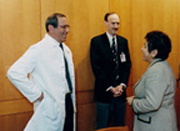 |
|
HHS Secretary Donna Shalala paid a visit to NIH
last month, which included a tour of the Clinical Center and
presentations by several NIH researchers. At left, CC Director
Dr. John Gallin, left, and Dr. Ronald Summers, center, greet
the Secretary as she arrives at the CC. Dr. Summers, of the CC
Diagnostic Radiology Department, then gave a talk on virtual
bronchoscopy and virtual colonoscopy, noninvasive ways of examining
the airway or colon by use of high-resolution CT scans. |
| At right, getting a bird's-eye view
from high up in the ACRF, Secretary Shalala is briefed on the
construction of the new Clinical Research Center. Yong-Duk Chyun,
CRC project director, foreground, explains the new floor plan,
while CC Director Dr. John Gallin, left, NIH Director Dr. Harold
Varmus, and ORS Director Steve Ficca, far right, look on. |
|
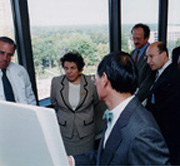 |
index
|
New patient representative
Laura R. Cearnal was recently appointed acting patient representative
for the Clinical Center.
|
|
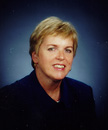 |
Laura R. Cearnal, R.N., M.S., was recently appointed acting
patient representative for the Clinical Center. Louise Faehner
left the position because of a move to California.
Cearnal has been with the CC for over 6 years. Most recently
she served as special assistant to the deputy director for clinical
care in the Office of the Director. Prior to that, she was head
nurse on the 4-West mental health procedure unit and the 4-East
adult schizophrenia unit, and before that she worked 10 years
with NIMH in clinical research.
"Many things about the role of the patient representative
appealed to me," said Cearnal. "I find direct interpersonal
contact with patients and families and with clinical and research
staff very rewarding. And it's a great pleasure to be working
with a wonderful group of volunteers who staff the O.R. waiting
room and visit new patients."
The patient representative is best described as an advocate.
Resolution of patient grievances, identification of areas for
improvement, problem-solving to meet patients' needs (either
individually or hospital-wide), answering questions, and identifying
resources are all functions of the job.
"The position serves as a direct link from the bedside
to the director of the Clinical Center, and as an open communication
channel between patients and their families and the institution,"
Cearnal said. "This position will continue to be an integral
part of many other hospital departments and programs to create
a seamless approach to patient concerns. Links to the Patient
Recruitment and Public Liaison Office, to the new Hospitality
Services Program, and to the Volunteer Service form a vital network."
At a research hospital such as the CC, there is the added
dimension of rights and responsibilities of patients who are
participating in clinical research.
"The patients our partners in clinical research
can teach us how to be even better, and this position provides
a voice for those lessons," she said. "I'd like patients
and families to feel comfortable coming to me or calling, confident
that I will listen to their ideas, complaints, concerns, and
compliments. I truly enjoy meeting our patients, and I appreciate
learning from them."
The patient representative can be reached at 6-2626.
index
|
|
Artwork donated
Pictured from left to right are Inna Krymova, Dmitry Krymov,
and Dr. John Gallin.
|
|
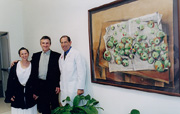 |
Dmitry Krymov, a Russian artist, recently donated his painting
"Apples" to the Clinical Center's permanent art collection.
Krymov's wife, Inna Krymova, is a CC patient, and the couple
wanted to express their appreciation for the care she receives
here.
Krymov is a well-respected artist, stage designer, graphic
designer, book and magazine illustrator, and sculptor, living
and working in Moscow. Several of his works are in the permanent
collections of the National Russian Museum in St. Petersburg
and the National Tretyakovsky Museum in Moscow.
Krymov offered several of his works for the CC to select from.
"This piece was the unanimous choice of the selection group,"
said CC Director Dr. John Gallin. Krymov created "Apples"
in 1993, using paper, mixed media, and a type of water-based,
opaque paint called gouache. The work hangs at the end of the
visitor-side hallway that leads up from the South Lobby.
index
|
|
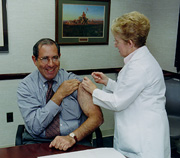
index
|
|
Big shot
Last month, CC Director Dr. John Gallin rolled up his sleeve
to receive his annual flu shot from Muriel Brenner, R.N., of
OMS. Even if you missed your scheduled day, it's still not too
late to get your flu shot. Doing so will help protect you, your
colleagues, and our patients from getting the flu. The OMS clinic
on the 6th floor will offer flu shots on a walk-in basis from
7:30 a.m. to 11 a.m. and from 1 p.m. to 5 p.m., on Nov. 19, 22,
23, and 24. After that, call 6-4411 to schedule an appointment.
|
News briefs
Health forum
NIH wants to "Share the Health" with its neighbors
on Saturday, Nov. 6, from 8 a.m. to 12 noon, at the Natcher Conference
Center. The event features health seminars, exhibits, free health
materials, presentations by elected officials, interactive computer
and WebTV demonstrations, tours, volunteer opportunities, and
more. For more information, call Terry LaMotte or Jessica Harrison
of Palladian Partners at 301-650-8660, or visit the web site
at http://health.info.nih.gov/forum99/
ClinPath auction
Join in the fun Dec. 3, at the 27th annual Clinical Pathology
holiday auction in Bldg. 10, Room 2C310. A bake sale starts at
9 a.m., and the silent auction and white elephant sale start
at 11 a.m. Have a slice of pizza while you browse. The event
will benefit the Patient Emergency Fund and the Friends of the
Clinical Center. Over $2000 was raised last year. To donate items
for sale, call Norma Ruschell at 6-4473.
Studies open
Call the Patient Recruitment and Public Liaison Office at
1-800-411-1222 for information on the following studies:
Uveitis: NEI researchers seek women in their first
6 months of pregnancy who have uveitis or history of uveitis.
NEI provides eye examinations, evaluation, and treatment as needed
at no cost to participants.
Psoriasis: NCI researchers seek adults who have psoriasis
on at least 10 percent of their skin for a study of a new medication.
The study will last 3 months, and there is no cost to participants
for the new medicine
Transport week
The Patient Escort Service celebrates National Transport Week,
Nov. 15, with a display on the first floor from 9 a.m. until
2 p.m. daily. Try your luck in the 5th annual transport raffle.
The winner will receive exclusive transport service for 8 hours
to the patient care area of their choice. Last year over $1000
was donated to the Patient Emergency Fund. Raffle tickets cost
$1, and are available from any member of the Patient Escort team.
Tickets will also be sold in front of both cafeterias and at
the
display.
Heart disease study
The Heart Disease Risk Factors in African-Americans Study
seeks new participants for a study of the relationship between
obesity and heart disease risk factors in healthy, nondiabetic
African-American men and women. Participants can be of normal
weight, overweight, or obese and between the ages of 18 and 55.
There will be a series of four outpatient visits to the Clinical
Center, in which participants will have body fat analyses, an
electrocardiogram, blood tests, including cholesterol profiles,
and oral and intravenous glucose tolerance tests. All participants
will be compensated. For more information, call 2-7119.
fMRI study
NIMH researchers seek volunteers for fMRI studies of the visual
processing of faces. Volunteers should have no history of medical
or psychiatric disorders and must have normal vision or wear
contact lenses. A
2-hour screening interview, a follow-up visit, and a 3-hour visit
for the fMRI scan are required. Participants will be reimbursed.
Specifically needed are:
- men aged 56-73 and women aged 51-59 who are right-handed
and currently married, and
- right-handed mothers aged 20-40 with nonadopted, firstborn
children aged 5-12.
For further details, call Lisa Kalik or Neil Santiago at 6-8381.
Bring a friend
November is "Bring a Friend" month in the Department
of Transfusion Medicine. If you bring a friend to donate blood
when you donate, you'll double the help you're providing to others.
To schedule an appointment, call 6-1048.
Clutter control
Want to clean out your offices and labs for a fresh start
in the new millennium? Visit a new web site, http://goodriddance.nih.gov,
for information and instructions on how to dispose of unwanted
computer equipment, laboratory equipment, hazardous materials,
reagents, furniture, and more. For details, contact Rosamond
Burns at 6-2346, or rrburns@helix.nih.gov
index
|
Clinical Center News, 6100 Executive
Blvd., Suite 3C01, MSC 7511, National Institutes of Health, Bethesda,
MD 20892-7511. Tel: 301-496-2563. Fax: 301-402-2984. Published
monthly for CC employees by the Office of Clinical Center Communications,
Colleen Henrichsen, chief. News, article ideas, calendar events,
letters, and photographs are welcome. Deadline for submissions
is the second Monday of each month.
top | cc
home page | nih home
page | |
|

